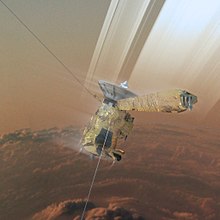
Back تقاعد كاسيني Arabic Fin de Cassini Spanish Aposentadoria da Cassini Portuguese Завершення місії Кассіні Ukrainian

The Cassini space probe was deliberately disposed of via a controlled fall into Saturn's atmosphere on September 15, 2017, ending its nearly two-decade-long mission.[1][2][3][4] This method was chosen to prevent biological contamination of any of the moons of Saturn now thought to offer potentially habitable environments.[5] Factors that influenced the mission end method included the amount of rocket fuel left, the health of the spacecraft, and funding for operations on Earth.[6]
Some possibilities for Cassini's later stages were aerobraking into orbit around Titan,[6] leaving the Saturn system,[6] or making close approaches and/or changing its orbit.[6] For example, it could have collected solar wind data in a heliocentric orbit.[3]
- ^ Brown, Dwayne; Cantillo, Laurie; Dyches, Preston (September 15, 2017). "NASA's Cassini Spacecraft Ends Its Historic Exploration of Saturn". NASA. Retrieved September 15, 2017.
- ^ Chang, Kenneth (September 14, 2017). "Cassini Vanishes Into Saturn, Its Mission Celebrated and Mourned". The New York Times. Retrieved September 15, 2017.
- ^ a b Spilker, Linda (April 1, 2008). "Cassini Extended Missions" (PDF). Lunar and Planetary Institute. Archived (PDF) from the original on April 23, 2008.
- ^ Mason, Betsy (February 3, 2010). "Cassini Gets Life Extension to Explore Saturn Until 2017". Wired. Archived from the original on February 9, 2010.
- ^ Blabber, Phillipa; Verrecchia, Angélique (April 3, 2014). "Cassini-Huygens: Preventing Biological Contamination". Space Safety Magazine. Retrieved August 1, 2015.
- ^ a b c d Cite error: The named reference
casswas invoked but never defined (see the help page).